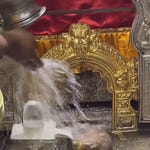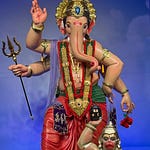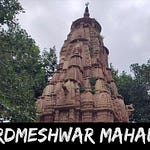"युध्यध्वमनहंकारा यतो धर्मस्ततो जयः" — Fight the war without arrogance; where there is Dharma, there is Victory.
(Mahabharata)
In the windswept sands of Rajasthan’s Thar Desert, close to the Indo-Pak border, stands a temple that defied the laws of physics, war, and fate—Tanot Mata Temple. It is not just a place of worship; it is a sanctuary where divine faith intersects with military valor, where myth becomes memory, and where the sacred meets the strategic.
The Divine Origins: A Warrior Goddess in the Desert
The temple is dedicated to Tanot Mata, revered as an incarnation of Goddess Hinglaj Mata—a principal form of the Mother Goddess in the Shakti Peetha tradition. She holds deep significance for the Charan community, who consider her their kuldevi (family deity), protector, and spiritual guide.
The foundation of this temple dates back to 828 AD, when Bhati Rajput King Tanu Rao installed the idol (vigraha) of Tanot Mata. From that moment on, this shrine became a seat of immense faith and cultural identity for generations in the region. It stood resilient amid scorching deserts, sandstorms, and centuries of political turmoil—its legacy rooted in both legend and history.
The 1965 Indo-Pak War: When Bombs Turned to Dust
During the Indo-Pakistani War of 1965, the strategic location of Tanot made it vulnerable to attacks. Pakistani forces launched an assault on the region, targeting both military posts and the revered temple. Over 3,000 bombs were reportedly dropped in the vicinity of the temple and on its premises.
Here lies the first miracle—none of the bombs exploded, nor did they cause any structural damage to the temple. Soldiers from the Border Security Force (BSF) and local villagers were left astonished. Testimonies from Indian Army personnel recount how they witnessed divine intervention and protection. The unexploded shells, now preserved in a museum inside the temple complex, silently narrate the story of a faith-protected frontier.
1971 War and the Battle of Longewala: The Desert Strikes Back
As fate would have it, Tanot Mata's protection would be summoned again—this time in the 1971 Indo-Pak war.
During the Battle of Longewala, Pakistani armored divisions moved towards Tanot through the harsh sands of the Thar. However, their tanks became immobilized in the desert, caught in nature’s trap. This delay proved critical. It gave the Indian Air Force and BSF just enough time to strike back with force. What followed was one of the most iconic victories in Indian military history.
The Vijay Stambha (Victory Tower) built within the temple compound now stands as a solemn tribute to the bravery of Indian soldiers and the divine presence that watched over them.
A Living Shrine Maintained by the Brave
In recognition of its spiritual and historical value, the temple is maintained by the BSF. Uniformed soldiers perform daily rituals and aarti, continuing the temple’s legacy with military discipline and spiritual devotion. The temple is both a site of pilgrimage and a guarded military post, where prayers are offered with the same intensity as sentry duty.
Visitors today can walk through the temple, observe the unexploded bombs in the museum, witness the morning and evening aartis, and experience an overwhelming sense of gratitude—for the divine, the brave, and the motherland.
Symbolism Beyond Religion: A Testament to India's Spirit
Tanot Mata Temple is more than a religious site. It symbolizes:
Faith in the face of destruction
Cultural resilience of Rajasthan
Courage of Indian armed forces
A fusion of spiritual and national identity
In an age of technology and skepticism, Tanot stands as a reminder that belief—whether divine or patriotic—has the power to shape history.
Few places in the world intertwine the sacred with the strategic, the miraculous with the military, and the ancient with the contemporary as Tanot Mata Temple does.
It remains a testament to how belief can protect borders, how the past informs the present, and how courage—both spiritual and physical—defines the soul of a nation.
Jai Mata Di. Jai Hind. 🇮🇳










